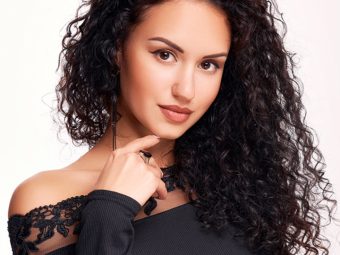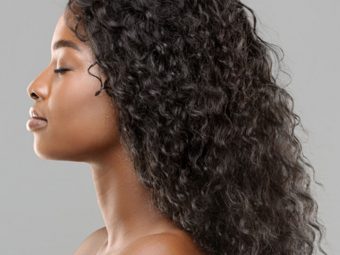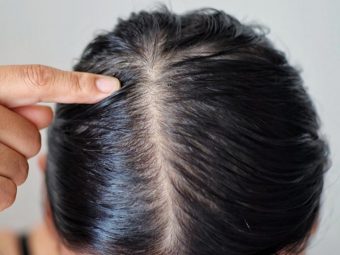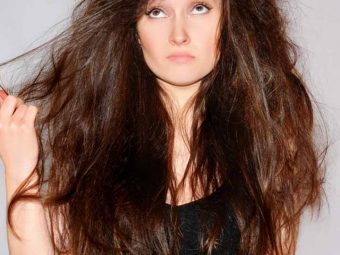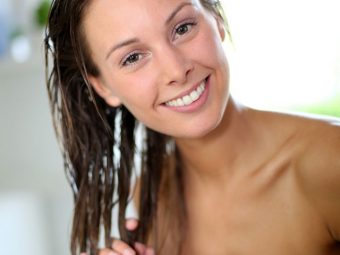Low Porosity Hair: Signs, Characteristics, Dos And Don’ts
Give your water-resistant mane extra TLC to keep it hydrated, healthy, and bouncy.
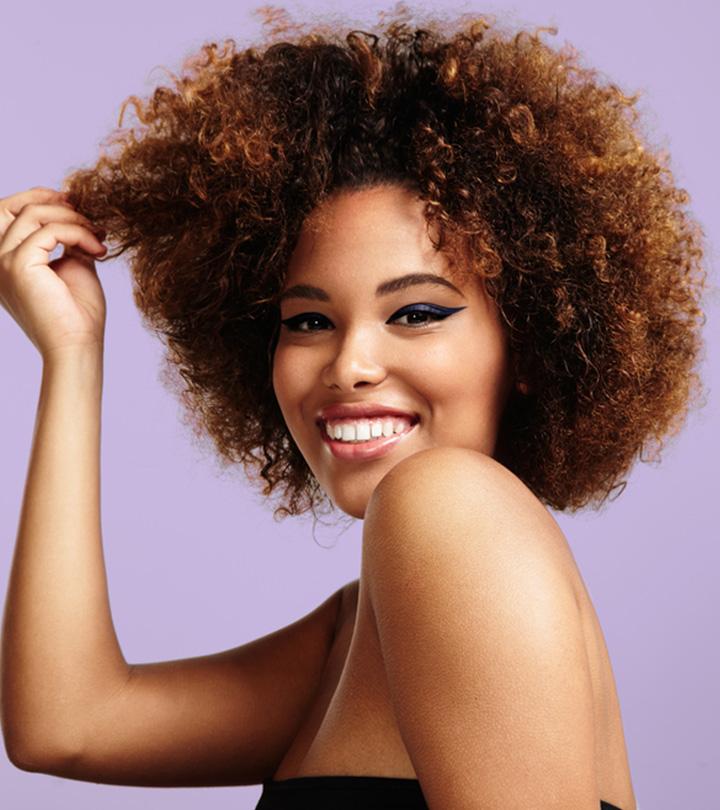
People with low porosity hair face trouble keeping their hair moisture locked in as the hair is impermeable. Low porosity hair breaks easily and grows slowly. It has a dry and bristly texture. Low porosity hair can be seen in people with curly hair, over-processed hair, and even natural hair. You can manage this condition if you take proper care. In this article, we talk about low porosity hair, managing it, home remedies, and much more. Keep scrolling!
In This Article
What Is Low Porosity Hair?
The porosity of hair depends on its ability to absorb and/or retain moisture. The three hair porosity types include low, normal, and high. The cuticles of low porosity hair type are closely packed and keep water or moisture from entering the hair. Such hair is moisture-resistant and eventually becomes rough, dry, frizzy, and prone to matting. Low porosity hair also tends to accumulate product buildup and feels rubbery to touch.
How can you know if you have low porosity hair or are going through a dry hair phase? Keep reading to find out.
How To Tell If You Have Low Porosity Hair?
The following tests can help determine if you have low porosity hair.
- Beaker Test: Take a glass beaker and fill ⅔ of it with water. Place 3-4 strands of your hair in the water. Strands that float on the surface have low porosity. If the strands sink to the bottom, you have porous hair (high porosity). If the hair strands sink just a little below the water surface and do not sink to the bottom, you have normal porosity hair.
- Spray Bottle Test: Section a part of your hair and spray some water. If the water forms beads that roll off, you have low porosity hair.
- Slide Test: Hold 2-3 strands of your hair and run your fingers through the hair strands. If they feel too bumpy throughout, you have low porosity hair.
Understanding the characteristics of low porosity hair can better help you in taking corrective measures.
Characteristics Of Low Porosity Hair
- Your hair takes some time to get wet.
- It cannot retain moisture beyond a day.
- It is extremely rough and dry.
- It tangles easily and is prone to matting.
- It is difficult to be colored.
- You can see product buildup.
Low porosity hair requires extra TLC to become softer, smoother, and healthier. You will learn how to take care of low porosity hair in the following section.
How To Take Care Of Low Porosity Hair?
- Use coconut oil: Coconut oil is rich in saturated fats that help moisturize rough and dry hair. Section your hair and take virgin coconut oil on your palm. Rub your palms together and apply it to each section from the root to the hair tip. Ensure each section is saturated with coconut oil. Leave the oil on for at least 45 minutes. You can also leave it on overnight before washing the following morning.
- Steam your hair: Steaming helps open up the cuticles. Open cuticles allow your hair to absorb and retain moisture. You can also use a face steamer (available at affordable prices online). Flip your hair down and steam your hair for 10-15 minutes (or more, depending on your hair thickness and texture). Curly hair tends to be on the higher extreme of lowporosity. Wrap your hair with a towel and allow the humid environment inside the towel to help your hair cuticles absorb the moisture.
- Apply a leave-in conditioner: A leave-in conditioner is a great way to help your hair get the nourishment and moisturization it needs. You can apply the leave-in conditioner after steaming your hair. Wait for at least an hour before washing. You can also leave the conditioner in for 24 hours.
- Twist your hair: Twist your hair if you have curly or kinky hair prone to damage, breakage, or tangling. Section your hair and apply a hair moisturizer. Twist your hair sections and leave them on for a day or two. Your hair will be softer, and the curls will be well-defined.
- Use the greenhouse effect: If you do not have the time for twist-outs, you may go for a simpler method. Apply coconut oil or almond oil to your hair and wear a shower cap. The heat from the scalp will get trapped and create a humid environment, opening up the cuticles and allowing the oil to penetrate the hair shaft.
- Use a clarifying shampoo: Low porosity hair tends to accumulate product buildup. Hence, use a clarifying shampoo to keep your scalp and hair clean.
- Use warm water: Lukewarm water opens up hair cuticles and helps wash away dirt and products. It also allows the conditioner to go into the cuticles and makes the hair softer.
- Dilute your conditioner: Diluting the conditioner will make its moisturizing properties more accessible to each hair strand.
- Use a serum: Use argan oil, olive oil, or almond oil as a hair serum. The serum will keep your hair hydrated, nourished, and shiny.
- Wear a satin cap: Tie your hair into a bun or braid your hair and wear a satin cap. This prevents further roughness and frizz. It also will keep your hair strands from getting rubbed against the pillow while you sleep.
Follow these methods regularly, and you will see a world of difference in your hair health. Your hair will become softer, smoother, tangle-free, frizz-free, and healthy. Note that you have to be patient to start seeing the results. This is especially true if you have 4C hair type or damaged hair.
Before closing, let us look at certain dos and don’ts.
Low Porosity Hair – Dos and Don’ts
- Avoid using products with silicone. Silicones like dimethicone, amodimethicone, and cyclomethicone are not water-soluble. They will form a coat on the hair and will further prevent water from entering the hair shaft.
- Use a leave-in conditioner containing plant oils and not chemicals. The former reduce product buildup.
- Avoid excess blow-drying or heat styling.
- Avoid coloring or bleaching your hair frequently.
- Do not leave your hair open while you sleep. Also, ensure to always sleep with a satin cap.
- Use a water softener or a filter if your area has hard water.
- Get a hair spa at least once a month. If not, use a steamer at home.
The porosity of hair is determined by its ability to absorb and hold moisture. Low porosity hair is coarse, rough, and frizzy. Irrespective of the hair type, tightly closed cuticles require prompt attention. The hair strands absorb and retain moisture better with open cuticles. They also help to remove grime and buildup. Therefore, your hair necessitates extra attention. Learning the characteristics of low porosity hair will aid you in taking appropriate corrective action. If you follow the above tips regularly, your hair will begin to respond positively to the therapy.
Frequently Asked Questions
Is rice water good for low-porosity hair?
Rice water is ideal for hair growth (1). Therefore, as long as it is used in moderation, low-porosity hair may reap its benefits too.
Is aloe vera good for low-porosity hair?
Aloe vera moisturizes the hair (2). Therefore, low-porosity hair may benefit from it too.
Is keratin good for low-porosity hair?
Keratin is a type of protein. Since low-porosity hair has protein-rich cuticles, adding keratin to it may not be ideal.
Key Takeaways
- Low-porous hair doesn’t retain moisture for too long, so it is bound to get dry and frizzy.
- If your hair does not sink in a beaker of water, consider you have low-porous hair.
- This hair type cannot withstand heat or harsh chemicals, so avoid excess blow-drying, heat styling, coloring, and bleaching.
- Keep the hair nourished by using the right products like virgin coconut oil, leave-in moisturizers, serums, clarifying shampoo, etc.
Sources
Articles on StyleCraze are backed by verified information from peer-reviewed and academic research papers, reputed organizations, research institutions, and medical associations to ensure accuracy and relevance. Read our editorial policy to learn more.
- USE OF RICE WATER (Oryza sativa) & HIBISCUS (Hibiscus rosa-sinensis) FOR HAIR NUTRITION AND HAIR GROWTH
https://www.jetir.org/papers/JETIR2106426.pdf - Aloe vera : A Potential Herb and its Medicinal Importance
https://www.jocpr.com/articles/aloe-vera–a-potential-herb-and-its-medicinal-importance.pdf





